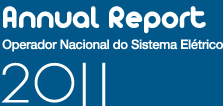Evolution of Processes and Methodological Improvements
In 2011, ONS made significant advances in improving the computer modeling used in the planning and scheduling of energy operation, with partnerships established through agreements with several national and foreign universities.
In this context, it stands out the realization of a workshop in May on multiple criteria analysis for the decision support and its applications in the Brazilian electric sector with the participation of the University of Coimbra.
Under the agreement with the University of Georgia, United States, which aims to investigate and propose improvements in the use of stochastic dual dynamic programming algorithm (SDDP) used to solve the problem of operation planning, the strategy analysis of numerical solution resulted in the proposal of improvements that can bring a reduction of up to 1/7 of the time in computational effort required to solve the problem of energy optimization, without loss of accuracy.
Still in this Agreement, in the methodological field, it was developed a proposal for a more robust approach to the representation of risk aversion, by minimizing a linear combination of the expected cost of operation, as current assumption of the model, with the representative cost of critical scenarios consisting of alternative to the approaches already used in planning and scheduling of the operation for energy security, which are the curve of risk aversion and the Short-Term Operating Procedures.
ONS also monitored the five lines of research developed by universities to improve the modeling used in the planning of energy operation, in response to a public call from ANEEL to guide the use of the resources for R & D that are collected from electricity consumers.
The Hydroexpert system was incorporated into the programming process of the hydraulic operation for flood control, whose application to the reservoirs of Paraná river basin was coordinated by ONS in supporting the definition of the hydraulic operation during the flood that occurred in this basin in the month of March. It was also initiated the project of improvement of the Hydroexpert for its application to Iguaçu River basin.
In the field of flood control, it was developed an improvement of the model OPCHEN, with the implementation of the alternative recovery of the stores at the end of the wet season, based on hydrometeorological forecasting, without loss to the protection against floods and with gains for the energy supply.
In the field of hydrometeorological forecasting, studies of application and testing with rainfall-runoff modeling in the basins of the rivers Grande and San Francisco were concluded. In the Basin of Sao Francisco River - in the incremental stretch between Tres Marias and Sobradinho plants- the model employed was NEUROSF, which was submitted to ANEEL at the end of the year to permit its use in the PMO. In the basin of Rio Grande, in the incremental stretches of Marimbondo and Água Vermelha plants, SMAP model application was expanded, already implemented for streamflow forecasting in plants located in the upstream stretch of the river basin. It was also initiated the study of SMAP model application for Paranaíba River basin, upstream of Itumbiara plant.
It also stands out the beginning of a project evaluating new alternatives for the weather forecast, which comprise a new parameterization of ETA model, currently in use in the process of streamflow forecasting for the PMO, and the new model BRAMS, which has characterization of the type and use of the soil adapted to the conditions in Brazil.
As part of the actions necessary for the provision of resources for management security power, ONS has continued the implementation of strategic action of Organon as a tool for assessing BIPS operation security. In 2011, models were revised and added improvements to this program, with special focus on the use of Special Protection Systems in electromechanical simulations to evaluate the use of Organon in monitoring the energy imports limits of the Southeastern region using the Itaipu 60 Hz transmission trunk.
The User’s Guide of Organon Program has been revised, as well as its database models for electromechanical components simulation, which resulted in outcomes consistent with other simulation tools used in operation planning and scheduling. It was shown that the current version of the program already allows the correct representation of Special Protection Systems in electromechanical simulations.
The use of Organon in the planning process for the calculation of limits involving Itaipu 60 Hz generation and the Southeastern region energy imports proved to be very advantageous, reducing the analysis time and allowing the exploitation of a greater number of energy scenario including even those with lower probability of occurrence. The results indicate that the area of security developed for calculating the Southeastern imports was consistent with the results obtained in the operation planning processes, proving the adequacy of the representation of the supervision network for studies involving South-Southeast interconnection.
The feasibility of providing a security region monitoring feature in portable devices with Internet access resources was demonstrated by the prototype.
As a complementary action to the implementation of the program Organon it was developed a comprehensive internal training program which is expected to continue in 2012, including agents potentially interested in using the program.
Throughout 2011, programmed activities were carried on implementation of RTDS simulator (Real Time Digital Simulator) to support the operation of the transmission system of Madeira River plants. It was defined a team of two engineers responsible for implementation and operation of the simulator in real time, and adjustment and improvement of the software infrastructure to support the activities of the simulator and off-line studies.
Technical visits to the manufacturer – ABB, in Ludvika, Sweden – were made for training and testing of replica cubicles used in the back to back converters of the Madeira Project. The monitoring of RTDS simulations for adjusting the parameters of such controllers was also covered in this visit. Technical visits were also made to the leading suppliers of real time power system simulators and offline simulator applied to electrical studies of DC links in Canada.
